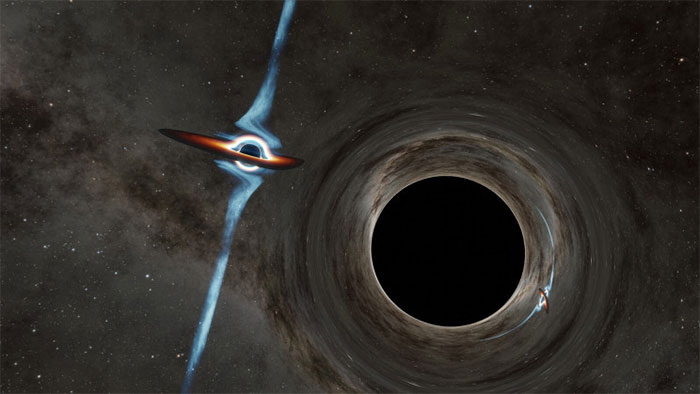Two black holes orbiting will collide strongly in the future
Astronomers from Caltech have discovered that two black holes, 9 billion light-years from Earth, are on the verge of a merger.

Predictive images of merging black holes.
Accordingly, the observations were made over the course of 13 years by astronomers at the Owens Valley Radio Observatory in Northern California. They revealed that a previously observed radio black hole at its center, PKS 2131-021 - has a companion black hole. This makes it a super-large binary pit. Quasars are active galactic cores in which supermassive black holes suck material from an accretion disk.
As Caltech reports, two supermassive black holes orbit each other every two years. Each object in the massive space has a mass hundreds of millions of times more than our Sun, and they are separated by a distance about 50 times greater than the space between our Sun and Pluto. Their findings are published in a paper in the Astrophysical Journal Letters.
The two black holes are expected to merge in about 10,000 years (a short time on a cosmic scale) resulting in a violent collision that is thought to send cascaded gravitational waves through the universe. In fact, in November 2021, astronomers from the University of Colorado Boulder published their report following computer simulations of two black holes at the centers of two colliding galaxies. They claim that the collision could cause a "gravity kick" so powerful that it could distort the shape of a galaxy.
Astronomers have detected an intense jet stream emanating from the vicinity of black holes. The jet was observed shifting back and forth. This is an indication of the pair's orbital motion detected through periodic variations in the brightness of radio light emitted by black holes.
The researchers explain that their discovery will help better understand the violent processes capable of changing the shape of the entire galactic structure. From there, they better understand our galaxy's cannibal past.
- Three huge black holes are about to collide in the universe
- Will humans migrate near the black hole in the end of the universe?
- Millions of black holes are hiding in our galaxy
- Decoding mistakenly thought that the black hole of the universe is
- Discover the mystery of the most exotic black holes in the universe
- 6 mysterious objects surround the black hole
- The pair of black superholes is 400 million light years from Earth
- Why can black holes glow?
- Unexpectedly discovered 5 mysterious black holes in the universe
- The galaxy has 3 black holes
- Observing the scene where two galaxies collide creates black holes
- Detected stunned the power of the supermassive black holes
 Van Allen's belt and evidence that the Apollo 11 mission to the Moon was myth
Van Allen's belt and evidence that the Apollo 11 mission to the Moon was myth The levels of civilization in the universe (Kardashev scale)
The levels of civilization in the universe (Kardashev scale) Today Mars, the sun and the Earth are aligned
Today Mars, the sun and the Earth are aligned The Amazon owner announced a secret plan to build a space base for thousands of people
The Amazon owner announced a secret plan to build a space base for thousands of people Black holes create mysterious swirling 'structures' that could open 'gateways' into dark matter
Black holes create mysterious swirling 'structures' that could open 'gateways' into dark matter  Surprising facts about the black panther - the inspiration for the character Black Panther
Surprising facts about the black panther - the inspiration for the character Black Panther  The nearest black hole discovered is only 150 light years from Earth
The nearest black hole discovered is only 150 light years from Earth  New discovery of the oldest black hole in the universe
New discovery of the oldest black hole in the universe  The Black Pyramid and the tragedy of deep oblivion: A thousand years later, still no escape from the tragedy of tomb raiding
The Black Pyramid and the tragedy of deep oblivion: A thousand years later, still no escape from the tragedy of tomb raiding  Exploring the 'Black Box of the Earth' project: A device that records the process of human extinction
Exploring the 'Black Box of the Earth' project: A device that records the process of human extinction 